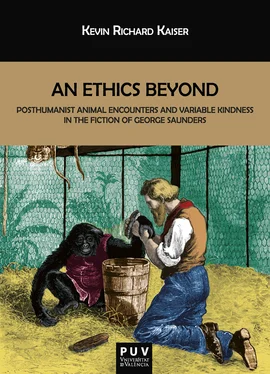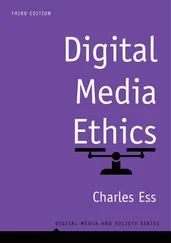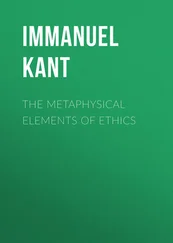As Jeff Turrentine boasts in his review of Tenth of December for The Washington Post , Saunders’s writing helps us to understand “the connections among sexism, racism, post-colonialism, late-stage capitalism and white middle-class anxiety” (2013, n.p.). I add that Saunders also helps us to understand the connections among further issues, whether they be sociocultural, sociopolitical, ecological, or axiological. In this sense, his writing is interdisciplinary. However, before addressing any of the multiple points I have mentioned, which will unfold in the following chapters, a contextualization of Saunders’s writing is due.
Chapter 1
Empathy and Satire:
The Fiction of George Saunders
“The Moral Acculturation of Empathy”: Saunders and Satire
George Saunders follows the sensibility of American “dark” satire, which perhaps stems in part from the American tradition of free speech as upheld in Hustler Magazine v. Falwell (1988). 3American dark satire, especially contemporary American dark satire, is rarely if ever strictly Horatian, Juvenalian, or Menippean; it is satire as a mode rather than a genre. Many critics are quick to indicate the satire at play in Saunders’s stories. However, few have analyzed in quite the manner Layne Neeper has.
In “‘To Soften the Heart’: George Saunders, Postmodern Satire, and Empathy” (2016), Neeper analyzes how Saunders’s satire, as a reimagining of the satiric formula, prods us toward empathy. By staying
with his post-modernist proclivities, Saunders burlesques the quotidian horrors and degradations visited upon characters in a nearly parallel universe to our own contemporary American life, but without even the faintest possibility of prescriptive remedies, instead supplanting the logos of traditional satire, the reasonableness of implied correction, with the pathos of empathetic recognition, an absurd alternative, but the only alternative, given the grotesqueries of Saunders’s fictional worlds and hapless characters that inhabit them. That his work may still be categorized as satirical resides in the fact that the fiction is transactional—readers should feel moved to change, to overcome something —but the sole upshot of Saunders’s satire is to lead to the moral acculturation of empathy in readers, so that we are put in “the proper relation to the truth,” rather than to the inducement to the righting of personal faults or social ills, the avowed aim of the conventional satirist. (Neeper 286-287, italics original)
This transactional quality has been mentioned by Saunders in interviews. For him, empathy comes from a pact between himself and the reader.
One way to reach this empathetic connection is through satire. According to Brian A. Connery and Kirk Combe in their introduction to Theorizing Satire (1995), reading satire is more perilous than “general” reading. They assert that the danger occurs because “satirists specialize in demolition projects. The one thing we know about satire is that it promises to tell us what we do not want to know—what we may, in fact, resist knowing. One is apt to find one’s former consciousness uninhabitable when the work of the satirist is done” (Connery and Combe 1). Connery and Combe may go a bit far to claim that satirists specialize in “demolition projects,” especially because Saunders’s writing is subtler. He does not “tell us” what we do not care to know but insinuates it. His writing, however, does leave the “consciousness,” if not altogether uninhabitable, at least altered. Unlike many satirists, his aim is to attune us to compassion.
Saunders follows the satiric mode found in Mark Twain, Kurt Vonnegut, and Donald Barthelme and unsurprisingly has written essays concerning all three, which are included in his collection of essays, The Braindead Megaphone (2007). In “The United States of Huck,” 4originally published as the introduction for a Modern Library paperback edition of Adventures of Huckleberry Finn (1885), Saunders dubs Twain “the funniest literary American writer,” describing his humor as “energetic and true and pure” (189). Huck Finn , as Saunders refers to the novel, addresses politics not by being politically incorrect for the sake of a joke but by showing us the political—and personal—stakes of language made taboo in Twain’s life (most notably through Huck’s quandary over the “nigger,” Jim, and whether to turn him in). Saunders’s assessment is that Twain’s “book was making [Twain] uncomfortable. His comic novel was doing things a comic novel was not supposed to do” because “his subconscious was urging him do things his conscious mind didn’t know could be done, or didn’t particularly want done” (USH 191). Saunders’s writing uses idiosyncratic language in a manner akin to how Twain uses language in Huck Finn : it divulges what is at stake in contemporary American sociopolitical culture. Saunders develops a theory, which he facetiously calls, in typical Saundersian fashion, a “Tentative Narrative Theory” of Twain’s “Apparent Narrative Rationales.” His theory is that Twain’s “tension between various warring parts of Sam Clemens—the radical and the reactionary; the savage satirist and the kindly Humorist; the raw hick and the aspiring genteel Literary Figure—is what makes Huck Finn such a rich and formidable book” (USH 191-192).
Those readers who approach Saunders by considering his similarities with Twain may find Saunders to be an author of similar tension. He is satirical yet kindly, a “blue collar” literary academic, but he seems more aware of these qualities in his writing; his literature entertains not despite its ethical awareness but because of it, even if the goal of writing is not “to be” ethical. Saunders contends that the ethical dilemma at the heart of the book—should Huck turn in Jim or not?—was not always clear to Twain, who
only dimly and imperfectly understood that his book had a Central Moral Vector. Or rather, he knew, but sometimes forgot. Or rather, he knew, but periodically got interested in other aspects of the book and lost sight of it. Or maybe, and most interestingly: his Central Moral Vector was too hot to handle, and would have required him to simultaneously invent, understand, and complete his book in an entirely new genre, a genre that neither Twain nor the world was quite ready for. (USH 197-198)
In Saunders’s fiction, the central ethical dilemmas are generally more clearly pronounced, more in focus than they are in Huck Finn , yet Saunders’s fiction is heir to this style of dark yet compassionate satire, more so than, for example, the satire found in “The Celebrated Jumping Frog of Calaveras County.”
In “Mr. Vonnegut in Sumatra,” 5an astute essay on Slaughterhouse-Five, or the Children’s Crusade: A Duty Dance with Death (1969), Saunders describes humor as “what happens when we’re told the truth quicker and more directly than we’re used to. The comic is the truth stripped of the habitual, the cushioning, the easy consolation” (80). In a sense, Saunders is reminding us of what has become a cliché regarding humor: it is funny because it is true. However, if we believe we laugh despite how we feel, this is not the truth. When we truly understand how we respond to that which unsettles us, we realize that when we laugh at satire we laugh because of how we feel; we laugh to release the tension. Dark satire is that which forces us to confront an unfiltered taboo that is otherwise too painful to consider, whether it be racism or death. We are tricked, in a sense, into confronting this painful issue. This is the reason why Vonnegut is, as Saunders states bluntly, a “funny” writer (MVS 77).
Читать дальше












